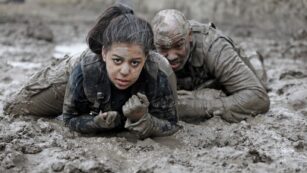Imagine the level of fitness required to be in the military—strength, endurance, agility, and mental toughness are just the basics. Military exercise routines are designed to build these qualities, ensuring soldiers are battle-ready and resilient. From rigorous boot camps to daily physical training, these exercises are a blend of intensity and discipline, pushing the limits of what the human body can endure.
Military Exercise Routine
Military personnel undergo rigorous exercise routines designed to meet the demands of battle, emphasizing strength, endurance, agility, and mental toughness. These routines are structured around specific fitness tests, tailored to each military branch’s requirements.
Army Physical Fitness Test (APFT) Routines
 The Army Physical Fitness Test (APFT) primarily focuses on cardiovascular fitness, muscular strength, and endurance. This test includes three main components: the two-mile run, sit-ups, and push-ups. Soldiers must complete these exercises in a sequence that tests their abilities to the maximum. For instance, they perform as many push-ups as they can within two minutes, testing upper body endurance and strength. Following push-ups, they execute as many sit-ups as possible in a two-minute period, targeting abdominal and core strength. The final component is the two-mile run, which assesses the soldier’s cardiovascular endurance. Training routines for the APFT often include interval runs, bodyweight exercises such as squats, lunges, and plyometrics, to enhance overall fitness and improve scores on the test.
The Army Physical Fitness Test (APFT) primarily focuses on cardiovascular fitness, muscular strength, and endurance. This test includes three main components: the two-mile run, sit-ups, and push-ups. Soldiers must complete these exercises in a sequence that tests their abilities to the maximum. For instance, they perform as many push-ups as they can within two minutes, testing upper body endurance and strength. Following push-ups, they execute as many sit-ups as possible in a two-minute period, targeting abdominal and core strength. The final component is the two-mile run, which assesses the soldier’s cardiovascular endurance. Training routines for the APFT often include interval runs, bodyweight exercises such as squats, lunges, and plyometrics, to enhance overall fitness and improve scores on the test.
Navy Physical Readiness Test (PRT) Routines
Navy Physical Readiness Test (PRT) routines focus on naval operation preparedness, emphasizing swimming efficiency, cardiovascular condition, and muscle endurance. Various exercises form part of the routine, including a 1.5-mile run or a swimming component, which sailors can choose based on their assignments and roles. Push-ups and curl-ups are also crucial to this test, requiring sailors to perform these exercises within strict two-minute intervals to gauge their muscular endurance. Navy exercise routines incorporate aquatic training to build stamina and improve swimming techniques, alongside traditional calisthenics and cardiovascular training. Specialized drills that simulate shipboard tasks are also included to enhance functional fitness and prepare sailors for the physical demands of naval service.
Benefits of Military Exercise Routines
Physical Health Improvements
 Participants in military exercise routines experience robust improvements in cardiovascular fitness. For example, the rigorous demands of the Army Physical Fitness Test and the Navy Physical Readiness Test require both endurance and muscular strength, which enhance heart health and increase lung capacity. Furthermore, these exercises promote functional strength by involving multiple muscle groups in compound movements, such as push-ups, sit-ups, and swimming. This approach ensures a comprehensive development in physical fitness, covering stamina, muscle endurance, and overall body strength.
Participants in military exercise routines experience robust improvements in cardiovascular fitness. For example, the rigorous demands of the Army Physical Fitness Test and the Navy Physical Readiness Test require both endurance and muscular strength, which enhance heart health and increase lung capacity. Furthermore, these exercises promote functional strength by involving multiple muscle groups in compound movements, such as push-ups, sit-ups, and swimming. This approach ensures a comprehensive development in physical fitness, covering stamina, muscle endurance, and overall body strength.
Mental Health Advantages
Engaging in military-style workouts also benefits psychological well-being. The structured nature of these exercises fosters discipline and focus, skills that are crucial for mental clarity and effective stress management. Moreover, the achievement of physical goals in a disciplined environment bolsters self-esteem and fosters a sense of accomplishment. Regular participation in such intense physical activities reduces symptoms of depression and anxiety, as the physical exertion releases endorphins, known as the “feel-good” hormones, which naturally improve mood and promote a more positive outlook on life.
Adaptations for Civilian Use
 Adopting military exercise routines offers a unique opportunity to elevate one’s physical and mental fitness. These routines are not just for soldiers but can be tailored to fit the needs of civilians looking to challenge themselves. By integrating aspects of the Army and Navy’s training programs civilians can develop a comprehensive fitness plan that enhances endurance strength and mental resilience.
Adopting military exercise routines offers a unique opportunity to elevate one’s physical and mental fitness. These routines are not just for soldiers but can be tailored to fit the needs of civilians looking to challenge themselves. By integrating aspects of the Army and Navy’s training programs civilians can develop a comprehensive fitness plan that enhances endurance strength and mental resilience.
While the rigorous nature of military workouts may seem daunting they are designed to scale based on individual fitness levels. This adaptability makes them accessible for beginners yet challenging enough for advanced fitness enthusiasts. Moreover focusing on functional movements ensures that participants gain real-world strength and agility.
Embracing the disciplined approach of military fitness not only boosts physical health but also cultivates psychological benefits such as increased discipline and improved focus. For those seeking a structured yet challenging regimen military-style workouts provide an excellent framework for achieving and maintaining peak physical fitness.

